Showing Spotlights 2513 - 2520 of 2851 in category All (newest first):
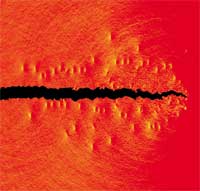 Bone is one of the most fascinating materials that has evolved in nature. There are 206 bones in your body - did you know that a newborn has 350 bones but they fuse together as you grow? - more than half of them in your hands and feet. These bones not only protect your organs, support your body against gravity's pull and allow you to move but they also are living tissues that produce blood cells and store important minerals. Not only important for humans, bones are the essential part of the endoskeleton of all vertebrates. Bone is a composite material of the mineral calcium hydroxyapatite and tropocollagen molecules (the fragile and soluble form of collagen when first synthesized by fibroblasts). It forms an extremely tough, yet lightweight material and its properties and behavior are of great interest to scientists and materials engineers. For instance, very little is known about the fracture behavior of bone and all such studies have been conducted at scales much larger than the nanoscale that explicitly considers individual tropocollagen molecules and mineral particles. New research at MIT has discovered a previously unknown toughening mechanism of bone that operates at the nanoscale - the level of individual collagen molecules and nano-platelets of hydroxyapatite. This breakthrough work lays the foundation for new materials design that includes the nanostructure as a specific 'design variable' and may help engineers to design materials from the bottom up by including hierarchies as a design parameter.
Bone is one of the most fascinating materials that has evolved in nature. There are 206 bones in your body - did you know that a newborn has 350 bones but they fuse together as you grow? - more than half of them in your hands and feet. These bones not only protect your organs, support your body against gravity's pull and allow you to move but they also are living tissues that produce blood cells and store important minerals. Not only important for humans, bones are the essential part of the endoskeleton of all vertebrates. Bone is a composite material of the mineral calcium hydroxyapatite and tropocollagen molecules (the fragile and soluble form of collagen when first synthesized by fibroblasts). It forms an extremely tough, yet lightweight material and its properties and behavior are of great interest to scientists and materials engineers. For instance, very little is known about the fracture behavior of bone and all such studies have been conducted at scales much larger than the nanoscale that explicitly considers individual tropocollagen molecules and mineral particles. New research at MIT has discovered a previously unknown toughening mechanism of bone that operates at the nanoscale - the level of individual collagen molecules and nano-platelets of hydroxyapatite. This breakthrough work lays the foundation for new materials design that includes the nanostructure as a specific 'design variable' and may help engineers to design materials from the bottom up by including hierarchies as a design parameter.
Jun 26th, 2007
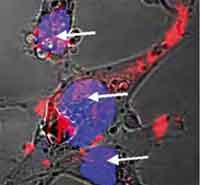 In chemotherapy doctors are using a carpet bombing approach to destroy cancer cells: the patient is pumped full of cytotoxic drugs, that go everywhere in the body, with the hope that enough of the drugs reach the cancer cells and target their nuclear DNA to damage it or destroy the cell. Not only do chemotherapeutic techniques have a range of often serious side effects, mainly affecting all the fast-dividing cells of the body, it also has been shown that often less than 1% of the administered drug molecules enter tumor cells and bind to the nuclear DNA. Another complication is drug resistance of cancer cells. This actually is one of the main causes of failure in the treatment of cancer. Dividing cancer cells acquire genetic changes at a high rate, which means that the cells in a tumor that are resistant to a particular drug will survive and multiply. The result is the re-growth of a tumor that is not sensitive to the original drug. Cancer researchers are looking to nanoparticles as a drug carrier capable of localizing and directly releasing drugs into the cell nucleus, thereby circumventing the multidrug-resistance and intracellular drug-resistance mechanisms to effectively deliver drugs to the vicinity of DNA, leading to a high therapeutic efficacy. Scientists now have developed nanoparticles capable of localizing into the nucleus, giving hope to a much more effective cancer chemotherapy that allows to pinpoint individual cells.
In chemotherapy doctors are using a carpet bombing approach to destroy cancer cells: the patient is pumped full of cytotoxic drugs, that go everywhere in the body, with the hope that enough of the drugs reach the cancer cells and target their nuclear DNA to damage it or destroy the cell. Not only do chemotherapeutic techniques have a range of often serious side effects, mainly affecting all the fast-dividing cells of the body, it also has been shown that often less than 1% of the administered drug molecules enter tumor cells and bind to the nuclear DNA. Another complication is drug resistance of cancer cells. This actually is one of the main causes of failure in the treatment of cancer. Dividing cancer cells acquire genetic changes at a high rate, which means that the cells in a tumor that are resistant to a particular drug will survive and multiply. The result is the re-growth of a tumor that is not sensitive to the original drug. Cancer researchers are looking to nanoparticles as a drug carrier capable of localizing and directly releasing drugs into the cell nucleus, thereby circumventing the multidrug-resistance and intracellular drug-resistance mechanisms to effectively deliver drugs to the vicinity of DNA, leading to a high therapeutic efficacy. Scientists now have developed nanoparticles capable of localizing into the nucleus, giving hope to a much more effective cancer chemotherapy that allows to pinpoint individual cells.
Jun 22nd, 2007
 A lot of buzz has been created by the term "green nanotechnology". In a broad sense, this term includes a wide range of possible applications, from nanotechnology-enabled, environmentally friendly manufacturing processes that reduce waste products (ultimately leading to atomically precise molecular manufacturing with zero waste); the use of nanomaterials as catalysts for greater efficiency in current manufacturing processes by minimizing or eliminating the use of toxic materials (green chemistry principles); the use of nanomaterials and nanodevices to reduce pollution (e.g. water and air filters); and the use of nanomaterials for more efficient alternative energy production (e.g. solar and fuel cells). Unfortunately, there is a flip side to these benefits. As scientists experiment with the development of new chemical or physical methods to produce nanomaterials, the concern for a negative impact on the environment is also heightened: some of the chemical procedures involved in the synthesis of nanomaterials use toxic solvents, could potentially generate hazardous byproducts, and often involve high energy consumption (not to mention the unsolved issue of the potential toxicity of certain nanomaterials). This is leading to a growing awareness of the need to develop clean, nontoxic and environmentally friendly procedures for synthesis and assembly of nanoparticles. Scientists are now exploring the use of biological organisms to literally grow nanomaterials.
A lot of buzz has been created by the term "green nanotechnology". In a broad sense, this term includes a wide range of possible applications, from nanotechnology-enabled, environmentally friendly manufacturing processes that reduce waste products (ultimately leading to atomically precise molecular manufacturing with zero waste); the use of nanomaterials as catalysts for greater efficiency in current manufacturing processes by minimizing or eliminating the use of toxic materials (green chemistry principles); the use of nanomaterials and nanodevices to reduce pollution (e.g. water and air filters); and the use of nanomaterials for more efficient alternative energy production (e.g. solar and fuel cells). Unfortunately, there is a flip side to these benefits. As scientists experiment with the development of new chemical or physical methods to produce nanomaterials, the concern for a negative impact on the environment is also heightened: some of the chemical procedures involved in the synthesis of nanomaterials use toxic solvents, could potentially generate hazardous byproducts, and often involve high energy consumption (not to mention the unsolved issue of the potential toxicity of certain nanomaterials). This is leading to a growing awareness of the need to develop clean, nontoxic and environmentally friendly procedures for synthesis and assembly of nanoparticles. Scientists are now exploring the use of biological organisms to literally grow nanomaterials.
Jun 21st, 2007
 The U.S. Department of Defense (DoD) has released its 2007 review of DoD nanotechnology programs. In 2007, estimated DoD nanotechnology expenditures will be $417m, about the same level as the year before. For the first time, however, the report lists the congressional additions to DoD's investment in nanotechnology. From 2005 to 2007, the Pentagon has requested about $350 million each year for its nanotechnology research. Congressional earmarks of $75.6 million in 2006 (actual) and $63 million in 2007 (estimate) have substantially increased this budget and given the Pentagon more money - and programs - than it actually asked for. The Pentagon report even states that "Congressional additions significantly complicate the assessment of current and proposed funding levels for the DoD investment in nanotechnology, since these Congressional appropriated programs commonly avoid the standard agency technical scrutiny. Furthermore, Congressional additions are often inconsistent with, or even in direct opposition to, the technical focus areas and directions of DoD agencies." Makes you almost feel sorry for the military... but it is yet another perfect example of how warped (sorry, can't use a stronger word here) the U.S. Congressional budget system has become.
The U.S. Department of Defense (DoD) has released its 2007 review of DoD nanotechnology programs. In 2007, estimated DoD nanotechnology expenditures will be $417m, about the same level as the year before. For the first time, however, the report lists the congressional additions to DoD's investment in nanotechnology. From 2005 to 2007, the Pentagon has requested about $350 million each year for its nanotechnology research. Congressional earmarks of $75.6 million in 2006 (actual) and $63 million in 2007 (estimate) have substantially increased this budget and given the Pentagon more money - and programs - than it actually asked for. The Pentagon report even states that "Congressional additions significantly complicate the assessment of current and proposed funding levels for the DoD investment in nanotechnology, since these Congressional appropriated programs commonly avoid the standard agency technical scrutiny. Furthermore, Congressional additions are often inconsistent with, or even in direct opposition to, the technical focus areas and directions of DoD agencies." Makes you almost feel sorry for the military... but it is yet another perfect example of how warped (sorry, can't use a stronger word here) the U.S. Congressional budget system has become.
Jun 20th, 2007
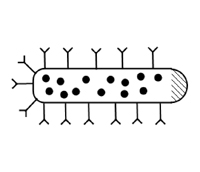 The ideal drug carrier may be something out of science fiction. In principle, it is injected into the body and transports itself to the correct target, such as a tumor, and delivers the required dose at this target. This idealized concept was first proposed by Paul Ehrlich at the beginning of the 20th century and was nicknamed the "magic bullet" concept. With the advent of nanotechnology and nanomedicine this dream is rapidly becoming a reality. Nanotechnology has already been applied to drug delivery and cosmetics through the use of liposomal technology, and now nanoparticles and nanotubes present an exciting and more promising alternative.
The ideal drug carrier may be something out of science fiction. In principle, it is injected into the body and transports itself to the correct target, such as a tumor, and delivers the required dose at this target. This idealized concept was first proposed by Paul Ehrlich at the beginning of the 20th century and was nicknamed the "magic bullet" concept. With the advent of nanotechnology and nanomedicine this dream is rapidly becoming a reality. Nanotechnology has already been applied to drug delivery and cosmetics through the use of liposomal technology, and now nanoparticles and nanotubes present an exciting and more promising alternative.
Jun 19th, 2007
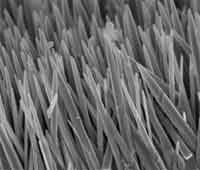 Large-scale and high-density semiconductor arrays with one-dimensional ("1D" - where one dimension of the structure is nanoscale) nanostructures have been extensively studied for their potential application in future electrooptical devices. Among them, zinc oxide (ZnO) is considered to be very attractive for high-efficiency short-wavelength optoelectronic nanodevices because of its large exciton binding energy of 60 meV and high mechanical and thermal stabilities. ZnO nanorod/ nanowire arrays have also been demonstrated to be highly versatile and proven to be quite effective in piezoelectric nanogenerators, dye-sensitized solar cells, photonic crystals, superhydrophobic surfaces, and even biodevices due to their biocompatibility. One of the issues researchers are still grappling with is the synthesis of ZnO nanowire arrays. On one hand, high-temperature techniques such as chemical vapor deposition (CVD) have been widely employed and result in high quality nanostructures. However, these methods are energy-consuming and expensive. On the other hand, there are several advantages of growing semiconducting nanostructures directly on conducting metal substrates, for instance the formation of robust electrical contacts during the growth. Such wet chemical methods, which are appealing for their low temperature, facile manipulation, and potential for scale-up have recently been developed for the production of aligned ZnO nanostructures and so far the most successful route has been seeded growth on ZnO-nanoparticle-coated substrates. In these two-step processes the coating of the substrate for the formation of a nucleation layer remains complex and difficult/irreproducible. Therefore, large-scale, low-cost controllable growth of well-aligned ZnO 1D nanostructures on properly fitting substrates via a one-step synthetic approach is still crucially needed for novel applications to become practicable. Researchers in China now have demonstrated exactly such a highly effective solution by growing well-aligned ZnO 1D nanostructures on various inert metal substrates at low temperature on a large scale.
Large-scale and high-density semiconductor arrays with one-dimensional ("1D" - where one dimension of the structure is nanoscale) nanostructures have been extensively studied for their potential application in future electrooptical devices. Among them, zinc oxide (ZnO) is considered to be very attractive for high-efficiency short-wavelength optoelectronic nanodevices because of its large exciton binding energy of 60 meV and high mechanical and thermal stabilities. ZnO nanorod/ nanowire arrays have also been demonstrated to be highly versatile and proven to be quite effective in piezoelectric nanogenerators, dye-sensitized solar cells, photonic crystals, superhydrophobic surfaces, and even biodevices due to their biocompatibility. One of the issues researchers are still grappling with is the synthesis of ZnO nanowire arrays. On one hand, high-temperature techniques such as chemical vapor deposition (CVD) have been widely employed and result in high quality nanostructures. However, these methods are energy-consuming and expensive. On the other hand, there are several advantages of growing semiconducting nanostructures directly on conducting metal substrates, for instance the formation of robust electrical contacts during the growth. Such wet chemical methods, which are appealing for their low temperature, facile manipulation, and potential for scale-up have recently been developed for the production of aligned ZnO nanostructures and so far the most successful route has been seeded growth on ZnO-nanoparticle-coated substrates. In these two-step processes the coating of the substrate for the formation of a nucleation layer remains complex and difficult/irreproducible. Therefore, large-scale, low-cost controllable growth of well-aligned ZnO 1D nanostructures on properly fitting substrates via a one-step synthetic approach is still crucially needed for novel applications to become practicable. Researchers in China now have demonstrated exactly such a highly effective solution by growing well-aligned ZnO 1D nanostructures on various inert metal substrates at low temperature on a large scale.
Jun 18th, 2007
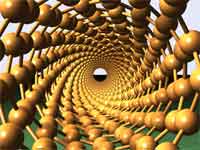 Just because something is really small doesn't mean it has to do with nanotechnology.
Just because something is really small doesn't mean it has to do with nanotechnology.
Jun 15th, 2007
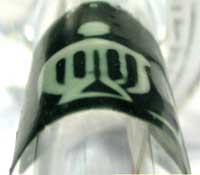 Thin, flexible displays have become an everyday component in many electronic gadgets from cell phones to digital cameras and MP3 players. Most of these displays are based on LCD technology, liquid crystals combined with polymeric structures, and one of their drawbacks is that their manufacturing cost grows rapidly with increasing screen size. A recently developed alternative approach for thin, flexible displays makes use of thermochromic composite thin-films. Thermo- chromism is the ability of a substance to change color due to a change in temperature. This first of a kind thermochromic display is based on films with thermochromic nanoparticles and embedded conductive wiring patterns. Based on the ease of fabrication and simple architecture, thermochromic displays could have advantages in lowering the display unit cost and, due to their heating pulse control scheme, can also lower power consumption compared with conventional displays.
Thin, flexible displays have become an everyday component in many electronic gadgets from cell phones to digital cameras and MP3 players. Most of these displays are based on LCD technology, liquid crystals combined with polymeric structures, and one of their drawbacks is that their manufacturing cost grows rapidly with increasing screen size. A recently developed alternative approach for thin, flexible displays makes use of thermochromic composite thin-films. Thermo- chromism is the ability of a substance to change color due to a change in temperature. This first of a kind thermochromic display is based on films with thermochromic nanoparticles and embedded conductive wiring patterns. Based on the ease of fabrication and simple architecture, thermochromic displays could have advantages in lowering the display unit cost and, due to their heating pulse control scheme, can also lower power consumption compared with conventional displays.
Jun 14th, 2007
 Bone is one of the most fascinating materials that has evolved in nature. There are 206 bones in your body - did you know that a newborn has 350 bones but they fuse together as you grow? - more than half of them in your hands and feet. These bones not only protect your organs, support your body against gravity's pull and allow you to move but they also are living tissues that produce blood cells and store important minerals. Not only important for humans, bones are the essential part of the endoskeleton of all vertebrates. Bone is a composite material of the mineral calcium hydroxyapatite and tropocollagen molecules (the fragile and soluble form of collagen when first synthesized by fibroblasts). It forms an extremely tough, yet lightweight material and its properties and behavior are of great interest to scientists and materials engineers. For instance, very little is known about the fracture behavior of bone and all such studies have been conducted at scales much larger than the nanoscale that explicitly considers individual tropocollagen molecules and mineral particles. New research at MIT has discovered a previously unknown toughening mechanism of bone that operates at the nanoscale - the level of individual collagen molecules and nano-platelets of hydroxyapatite. This breakthrough work lays the foundation for new materials design that includes the nanostructure as a specific 'design variable' and may help engineers to design materials from the bottom up by including hierarchies as a design parameter.
Bone is one of the most fascinating materials that has evolved in nature. There are 206 bones in your body - did you know that a newborn has 350 bones but they fuse together as you grow? - more than half of them in your hands and feet. These bones not only protect your organs, support your body against gravity's pull and allow you to move but they also are living tissues that produce blood cells and store important minerals. Not only important for humans, bones are the essential part of the endoskeleton of all vertebrates. Bone is a composite material of the mineral calcium hydroxyapatite and tropocollagen molecules (the fragile and soluble form of collagen when first synthesized by fibroblasts). It forms an extremely tough, yet lightweight material and its properties and behavior are of great interest to scientists and materials engineers. For instance, very little is known about the fracture behavior of bone and all such studies have been conducted at scales much larger than the nanoscale that explicitly considers individual tropocollagen molecules and mineral particles. New research at MIT has discovered a previously unknown toughening mechanism of bone that operates at the nanoscale - the level of individual collagen molecules and nano-platelets of hydroxyapatite. This breakthrough work lays the foundation for new materials design that includes the nanostructure as a specific 'design variable' and may help engineers to design materials from the bottom up by including hierarchies as a design parameter.
 Subscribe to our Nanotechnology Spotlight feed
Subscribe to our Nanotechnology Spotlight feed





